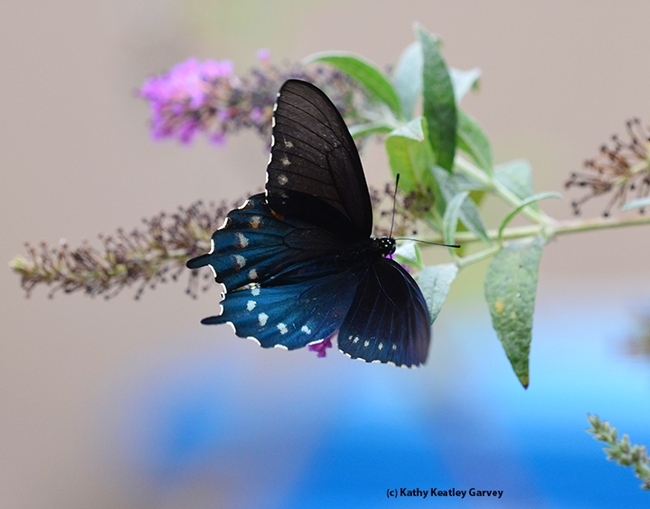Never say "pipe down" to a pipevine swallowtail.
It's a butterfly we treasure.
You may have seen it nectaring on your butterfly bush. It's black with blue iridescent upper wings and orange arrowhead-like spots on its inner wings.
Butterfly expert Art Shapiro, distinguished professor of evolution and ecology at the University of California, Davis, says on his website, Art's Butterfly World, that Battus philenor is "unmistakable and very conspicuous as both a larva and an adult."
So are the eggs. The eggs are red or rust-colored, while the larvae or caterpillars are black with red spots.
Shapiro describes Battus philenor as "the signature riparian butterfly of our region, occurring along streams in foothill canyons and on the Central Valley floor, essentially everywhere where its only host plant, California pipevine or Dutchman's pipe, Aristolochia californica, occurs."
The butterfly, also nicknamed "blue swallowtail," is found throughout North America and Central America.
"Adults are eager visitors to many flowers, including wild radish, California buckeye, blue dicks, Ithuriel's spear, and Yerba Santa," according to Shapiro. "In summer they regularly nectar at yellow starthisle when there are no native plants in bloom."
"This species is warningly colored and inedible to vertebrate predators," Shapiro writes. "It derives its protection from the toxic aristolochic acids produced by the host, which it sequesters; females even pass these along to the eggs, which are also protected (and are brick red, laid in bunches of up to 20, and quite conspicuous). Eggs are laid only on young, tender, growing shoot tips and the larvae must begin by feeding on these. Initially they feed in groups. As they get larger they scatter and can tackle large, mature leaves. But because these react to feeding damage by becoming more toxic and unpalatable, a larva will feed on a single leaf only for a short time and then has to move on. Eventually most or all leaves end up damaged, but few are badly damaged. The larvae also feed eagerly on the immature fruits, which look like small bananas with fluted edges. In big swallowtail years little if any seed ends up being set."
The adults live about a month.
So, let's enjoy them while we can! We followed this one around on our butterfly bush (Buddleja davidii) this afternoon as the sun dipped low in the sky. Usually, we see only the side view, but this one provided a dorsal view, flashing its colors.
Blue. Brilliant blue. iridescent blue.
Is any other blue so glorious?
Attached Images:

A pipevine swallowtail, Battus philenor, flashes its colors. (Photo by Kathy Keatley Garvey)

Side view of a pipevine swallowtail nectaring on a butterfly bush. (Photo by Kathy Keatley Garvey)

Pipevine swallowtail in a familiar pose. (Photo by Kathy Keatley Garvey)

Black and blue on blue. (Photo by Kathy Keatley Garvey)

Pipevine swallowtail in flight. (Photo by Kathy Keatley Garvey)